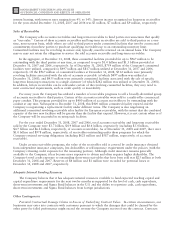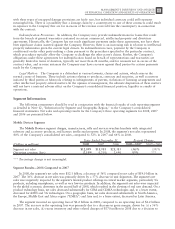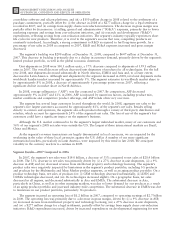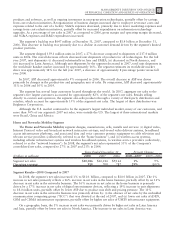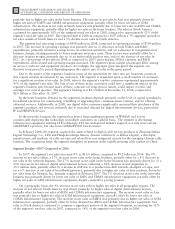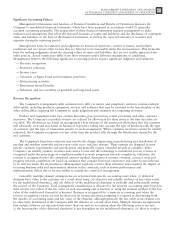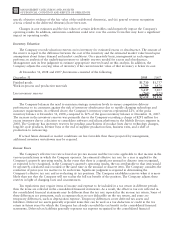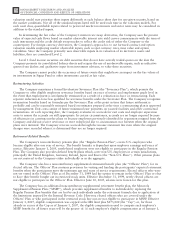Motorola 2008 Annual Report Download - page 68
Download and view the complete annual report
Please find page 68 of the 2008 Motorola annual report below. You can navigate through the pages in the report by either clicking on the pages listed below, or by using the keyword search tool below to find specific information within the annual report.
interest bearing, with interest rates ranging from 4% to 14%. Interest income recognized on long-term receivables
for the years ended December 31, 2008, 2007 and 2006 was $3 million, $7 million and $9 million, respectively.
Sales of Receivables
The Company sells accounts receivables and long-term receivables to third parties in transactions that qualify
as “true-sales.” Certain of these accounts receivables and long-term receivables are sold to third parties on a one-
time, non-recourse basis, while others are sold to third parties under committed facilities that involve contractual
commitments from these parties to purchase qualifying receivables up to an outstanding monetary limit.
Committed facilities may be revolving in nature and, typically, must be renewed on an annual basis. The Company
may or may not retain the obligation to service the sold accounts receivable and long-term receivables.
In the aggregate, at December 31, 2008, these committed facilities provided for up to $967 million to be
outstanding with the third parties at any time, as compared to up to $1.4 billion and $1.3 billion provided at
December 31, 2007 and 2006, respectively. As of December 31, 2008, $759 million of the Company’s committed
facilities were utilized, compared to $497 million and $817 million utilized at December 31, 2007 and 2006,
respectively. Of the $967 million of committed facilities at December 31, 2008, $532 million were primarily
revolving facilities associated with the sale of accounts receivable (of which $497 million was utilized at
December 31, 2008), and $435 million were primarily committed facilities associated with the sale of specific
long-term financing transactions to a single customer (of which $262 million was utilized at December 31, 2008).
In addition, before receivables can be sold under certain of the revolving committed facilities, they may need to
meet contractual requirements, such as credit quality or insurability.
For many years the Company has utilized a number of receivables programs to sell a broadly-diversified group
of accounts receivables to third parties. Certain of the accounts receivables were sold to a multi-seller commercial
paper conduit. This program provided for up to $400 million of accounts receivables to be outstanding with the
conduit at any time. Subsequent to December 31, 2008, this $400 million committed facility expired and the
Company is negotiating a replacement facility under different terms. The Company is also negotiating an
additional committed revolving receivable sales facility for European receivables, with the intent that the combined
capacity of the two new facilities will be greater than the facility that expired. However, it is not certain when or if
the Company will be successful in securing such facilities.
For the year ended December 31, 2008, 2007 and 2006, total accounts receivables and long-term receivables
sold by the Company were $3.7 billion, $4.9 billion and $6.4 billion, respectively (including $3.4 billion,
$4.7 billion and $6.2 billion, respectively, of accounts receivables). As of December 31, 2008 and 2007, there were
$1.0 billion and $978 million, respectively, of receivables outstanding under these programs for which the
Company retained servicing obligations (including $621 million and $587 million, respectively, of accounts
receivable).
Under certain receivables programs, the value of the receivables sold is covered by credit insurance obtained
from independent insurance companies, less deductibles or self-insurance requirements under the policies (with the
Company retaining credit exposure for the remaining portion). Although credit insurance remains generally
available to the Company, it has become more expensive to obtain and often requires higher deductibles. The
Company’s total credit exposure to outstanding short-term receivables that have been sold was $23 million at both
December 31, 2008 and 2007. Reserves of $4 million and $1 million were recorded for potential losses at
December 31, 2008 and 2007, respectively.
Adequate Internal Funding Resources
The Company believes that it has adequate internal resources available to fund expected working capital and
capital expenditure requirements for the next twelve months as supported by the level of cash, cash equivalents,
short-term investments and Sigma Fund balances in the U.S. and the ability to repatriate cash, cash equivalents,
short-term investments and Sigma Fund balances from foreign jurisdictions.
Other Contingencies
Potential Contractual Damage Claims in Excess of Underlying Contract Value: In certain circumstances, our
businesses may enter into contracts with customers pursuant to which the damages that could be claimed by the
other party for failed performance might exceed the revenue the Company receives from the contract. Contracts
60 MANAGEMENT’S DISCUSSION AND ANALYSIS
OF FINANCIAL CONDITION AND RESULTS OF OPERATIONS












